Evaluating the Carbon Footprint of Wood Buildings
Reducing greenhouse gases with high-performance structures
![]() Continuing Education
Continuing Education
Use the following learning objectives to focus your study while reading this month’s Continuing Education article.
Learning Objectives - After reading this article, you will be able to:
- Examine the natural cycle of carbon absorption and storage, and the role of forests and wood products in mitigating carbon emissions.
- Discuss the role of wood products sourced from sustainably managed forests in the design of sustainable, environmentally positive buildings.
- Explain the low embodied energy of wood products, and how this translates into avoided carbon emissions throughout their life cycles.
- Compare the carbon benefits of example buildings based on the results of two calculators.
Worldwide, there has been increasing focus on the carbon footprint of buildings and recognition that design professionals are uniquely positioned to reduce greenhouse gases in the atmosphere by creating high-performance structures.
According to Architecture 2030, which was established more than a decade ago in response to the climate change crisis, buildings are “the problem.” The building sector consumes nearly half of all energy produced in the United States, 75 percent of the electricity produced is used to operate buildings, and, in 2010, the building sector was responsible for nearly half of U.S. carbon dioxide (CO2) emissions. However, buildings also offer a solution. By 2035, approximately 75 percent of the nation's building stock will be either new or renovated (from a 2010 baseline). This transformation offers a significant opportunity to reduce the carbon footprint of the built environment.
Today, energy efficiency—once the new frontier for environmentally conscious designers—is a commonplace objective and net zero energy is well within reach. As a result, greater attention is now being focused on the materials used to construct buildings—and the benefits, carbon and otherwise, of using wood from sustainably managed forests instead of products that are fossil fuel-intensive.
Extensive research, some of it developed in countries where ambitious government policies promoting carbon efficiency are being implemented, and sophisticated new calculation tools are making it possible for architects to evaluate and compare the impacts of different materials on the carbon footprint of buildings. Similarly, there is an increasing number of life cycle assessment (LCA) tools that allow designers to evaluate and compare buildings based on a range of indicators such as air pollution, water pollution, and waste.
This course examines the environmental impacts of wood products—from the global scale of the world's forests to the individual scale of efficient, adaptable, and innovative buildings—using real-world examples from two U.S. carbon calculators as well as the latest research on LCA.
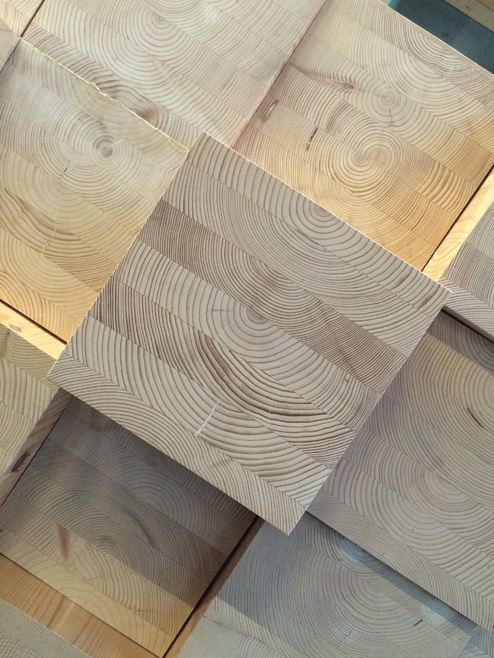
Architecture 2030 objectives are making many designers pay greater attention to the materials used to construct buildings and the benefits, carbon and otherwise, of using wood from sustainably managed forests instead of products that are fossil fuel-intensive.
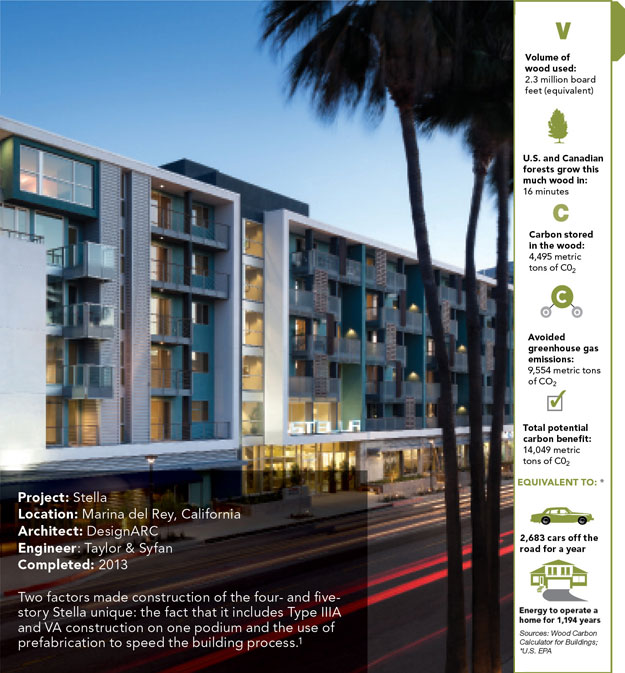
Photo by Lawrence Anderson, www.lawrenceanderson.net
Calculating Carbon Footprint
Much of the information available about the effectiveness of wood products in reducing a building's carbon footprint has been driven by an increasing focus on carbon elsewhere in the world. The European Union, for example, is seeking to reduce carbon emissions by having all new buildings achieve 'nearly net-zero energy' by 2020—i.e., very high energy efficiency where the low amount of energy that is required comes from renewable sources.
In The Netherlands, the 2012 building code requires LCA data to be submitted for each new building, and a total 'environmental shadow cost' must be calculated per square meter of building area in order to get a building permit.
The UK government will require new homes to be 'zero carbon' beginning in 2016, and is considering extending this to all buildings as of 2019.
Other policies go further, explicitly recognizing the benefits of forestry and wood use:
▶ In the UK, climate change policy includes carbon sequestration via tree planting and forest management, the production of wood fuel as a renewable energy source and the promotion of wood products as a substitute for more carbon intensive materials.
▶ In France, the government requires that new public buildings have at least 0.2 cubic meters of wood for every 1 square meter of floor area.
▶ In New Zealand, wood or wood-based products must be considered as the main structural material for new government-funded buildings up to four floors.
▶ The Japanese government introduced a law requiring wood to be considered as the primary building material for any government-funded project up to three stories, and for any privately funded building used in a public manner such as elderly care facilities.
▶ In Canada, the governments of British Columbia, Ontario, and Quebec have policies that encourage the use of wood in public buildings.
In the U.S., increasing emphasis on the effects of carbon in the atmosphere has motivated the development of many calculators for various products and activities. Two in particular are commonly used by U.S. architects to understand and compare the carbon impacts of their building designs.
Developed by the U.S. Environmental Protection Agency, the Greenhouse Gas Equivalencies Calculator2 translates emissions data into recognizable equivalents such as annual greenhouse gas emissions from passenger vehicles or CO2 emissions from the energy used to operate a home for a year. The second tool, the Wood Carbon Calculator for Buildings,3 was developed to allow users to calculate the carbon benefits of their wood building projects, including the amount of carbon stored in the wood products, emissions avoided by not using fossil fuel-intensive materials, and amount of time it takes North American forests to grow that volume of wood. It does this in one of two ways:
▶ If the volume of wood products is known (including lumber, panels, engineered wood, decking, siding, and roofing), the carbon calculator will provide a detailed estimate for that specific building. The more detailed the information, the better the results.
▶ If volume information is unknown, users can select from a list of common building types and receive an estimate based on typical wood use.
For the more detailed calculation, users enter the nominal volume of wood in a building, and the calculator then performs necessary volume conversions, makes corrections for moisture content, and arrives at a total mass figure of wood contained in the building. The tool then uses that information to estimate the building's carbon benefits.
Both the Greenhouse Gas Equivalencies Calculator and the Wood Carbon Calculator for Buildings were used to generate the equivalencies in this course.
Forests Absorb, Store, and Release Carbon
Responsibly managing forests in a way that balances harvesting and replanting, and provides a sustainable source of wood products that continue to store carbon and offset the use of fossil fuels, can significantly reduce the amount of carbon in the atmosphere over the long term.

Photo by Weyerhaeuser Company
On many public lands, years of fire suppression combined with a ‘hands off’ approach to management has created overly dense forests with a heightened risk of wildfire—and the resulting massive CO2 emissions. Active forest management, which includes thinning these forests to reduce the severity of fire when it occurs, protects values such as habitat and recreation while helping to ensure that forests store more carbon than they release.
As trees grow, they clean the air we breathe by absorbing CO2 from the atmosphere. They release the oxygen (O2) and incorporate the carbon (C) into their twigs, stems, roots, leaves or needles, and surrounding soil. Young, vigorously growing trees take up carbon dioxide quickly, with the rate slowing as they reach maturity (typically 60-100 years, depending on species and environmental factors). A single tree can absorb as much as 48 pounds of CO2 per year and sequester up to 1 ton of CO2 by the time it reaches 40 years old.4
As trees mature and then die, they start to decay and slowly release the stored carbon back into the atmosphere. Carbon is also released, but more quickly, when forests succumb to natural hazards such as wildfire, insects or disease.
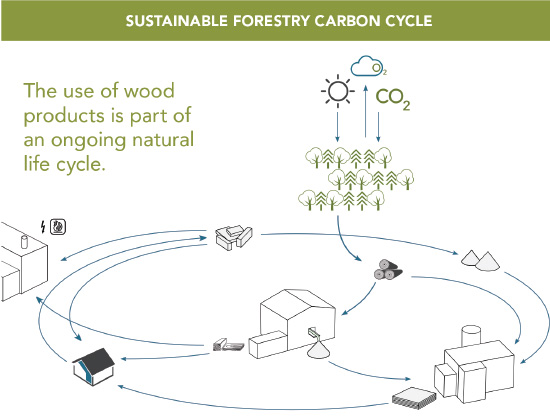
Source: Building with Wood – Proactive Climate Protection, Dovetail Partners Inc.
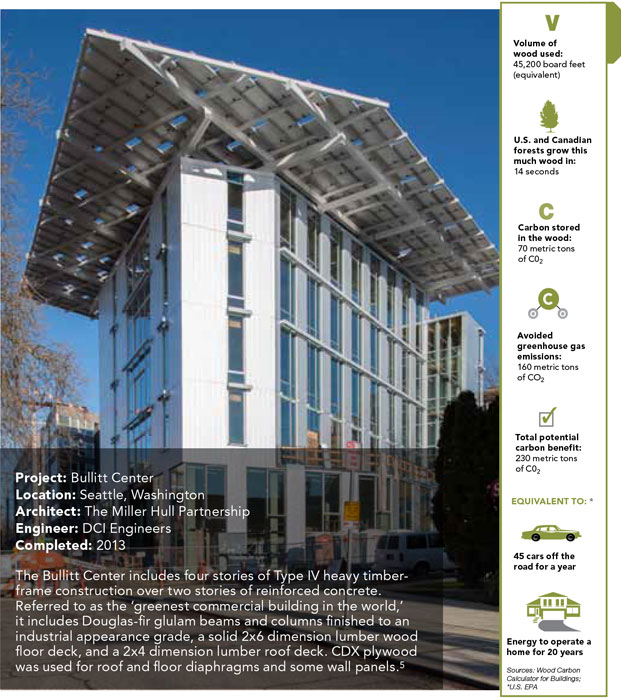
Photo by John Stamets
Growing forests absorb, store, and release carbon over extended periods of time. According to a new report by the Dovetail Partners consulting group, U.S. forests add more than twice as much wood through new growth annually than is removed or lost through natural mortality. As a result, wood volumes contained within the nation's forests have been increasing. Citing research from the U.S. Forest Service, the report states: “The amount of forestland area in the U.S. has been essentially constant since 1900. This reality and a long history of positive net growth (growth in excess of mortality and removals), coupled with improvements in forest management and supported by strong markets for forest products, have resulted in U.S. forests storing more carbon than they release into the atmosphere (i.e., they are a net carbon sink). In fact, scientists estimate that U.S. forests have been a net carbon sink since the early 1900s.” The Forest Service estimates that U.S. forests store approximately 67 metric tons of carbon per acre.6
These conclusions are echoed in the National Report on Sustainable Forests – 2010,7 which states, “Total U.S. forest area, as defined for the purposes of this report, currently amounts to 751 million acres, or about one-third of the nation's total land area. Since the beginning of the past century, the size of this inventory has been relatively stable, and the forests it represents remain largely intact…” In the U.S., forests and forest products store enough carbon each year to offset approximately 10 percent of the nation's total CO2 emissions.8
That said, changing environmental conditions have made the active management of forests critical. For example, wildfire is a natural and inherent part of the forest cycle. Today, however, wildfires must be prevented from burning unchecked because of danger to human life and property. As a result, many forests have become over-mature and overly dense with excess debris, which, combined with more extreme weather, has caused an increase in both the number and severity of wildfires. The combination of older forests and changing climate is also having an impact on insects and disease, causing unprecedented outbreaks such as the mountain pine beetle—which further add to the fire risk.
Active forest management, which includes thinning overly dense forests to reduce the severity of wildfires, helps to ensure that forests store more carbon than they release. Forest management activities aimed at accelerating forest growth also have the potential to increase the amount of carbon absorbed from the atmosphere. The International Panel on Climate Change (IPCC) has stated: “In the long term, a sustainable forest management strategy aimed at maintaining or increasing forest carbon stocks, while producing an annual sustained yield of timber, fibre or energy from the forest, will generate the largest sustained mitigation benefit.”9
Whether trees are harvested and used for products or decay naturally, the cycle is ongoing, as forests regenerate and young trees once again begin absorbing carbon. But when trees are manufactured into products and used in buildings, a new phase of carbon mitigation begins.
Wood Buildings Store Carbon
Wood is comprised of about 50 percent carbon by dry weight.10 So the wood in a building is providing physical storage of carbon that would otherwise be emitted back into the atmosphere. For example, according to the Dovetail Partners report, the structure of an average U.S. single-family home stores about 9.3 metric tons of carbon, which is equivalent to 34 tons of CO2.
In a wood building, the carbon is kept out of the atmosphere for the lifetime of the structure—or longer if the wood is reclaimed and reused or manufactured into other products. Wood stores more carbon than is emitted during its harvest, production, transport, and installation—even when transported over great distances.
As part of its report, Dovetail posits that increasing the use of wood in construction could significantly enhance carbon storage in the nation's building stock. According to the Forest Climate Working Group, a coalition that collaborates on forest carbon strategy and policy recommendations, the current inventory of wood structures in the U.S. is estimated to store 1.5 billion metric tons of carbon, which is equivalent to 5.4 billion tons of CO2. Most of this resides in the nation's housing stock, about 80 percent of which is wood-frame construction. Increasing wood use to the maximum extent feasible in multi-family housing, low-rise non-residential construction, and remodeling could result in a carbon benefit equal to about 21 million metric tons of CO2 annually—the equivalent of taking 4.4 million cars off the road indefinitely.
Another study, this one published collaboratively by researchers at Yale University and the University of Washington, estimates that using wood substitutes could save 14 percent to 31 percent of global CO2 emissions and 12 percent to 19 percent of global fossil fuel consumption.11
Wood has Low Embodied Impacts
Embodied energy—which is the energy required to harvest, manufacture, transport, install, maintain, and dispose or recycle a material—also contributes to wood's light carbon footprint. Life cycle assessment (LCA) studies, which consider the environmental impacts of materials over their entire lives, consistently show that wood performs better than other materials in terms of embodied energy, air and water pollution, and greenhouse gas emissions.
One of the reasons wood performs well is that it requires far less energy to manufacture than other materials12—and very little fossil fuel energy, since most of the energy used comes from converting residual bark and sawdust to electrical and thermal energy. For example, the production of steel, cement, and glass requires temperatures of up to 3,500°F, which is achieved with large amounts of fossil fuel energy. On average, the U.S. and Canadian forest industries generate about 65 percent and 60 percent of their energy needs (respectively) from sources other than fossil fuels.
A comprehensive review of scientific literature examined research done in Europe, North America, and Australia pertaining to life cycle assessment of wood products.13 It applied life cycle assessment criteria in accordance with ISO 14040-42 and concluded, among other things, that:
▶ Fossil fuel consumption, potential contributions to the greenhouse effect, and the quantities of solid waste tend to be minor for wood products compared to competing products.
▶ Wood products that have been installed and are used in an appropriate way tend to have a favorable environmental profile compared to functionally equivalent products made out of other materials.
Increasingly, architects and engineers are utilizing LCA as an objective way to compare the environmental impacts of their material choices. This is due in part to the fact that information on LCA, including databases, tools and research, is growing. For example, the Consortium for Research on Renewable Industrial Materials (CORRIM) undertakes LCA research, concentrating on U.S. products and materials.
In 2005 and 2010, CORRIM published the results of two phases of a landmark study comparing wood-frame and steel-frame homes in Minneapolis and wood-frame and concrete homes in Atlanta (the building types most common in those parts of the country). Phase II placed an emphasis on carbon footprint, and confirmed that the carbon stored in wood products offsets many of the emissions from other products. Despite the small total mass difference resulting from substituting steel or concrete framing for wood, the Global Warming Potential (CO2 equivalent of greenhouse gas emissions, including CO2, methane, and nitrous oxide) from the steel-framed house was 26 percent greater than the house with wood walls and floors, without considering the carbon stored in the wood products. This became a 120 percent difference when the carbon stored in the wood products for the life of the house was included. Emissions from the completed, concrete wall-framed house were 31 percent greater than the wood wall house without considering the carbon stored in wood products, and 156 percent greater when these carbon stores were included in the calculation.
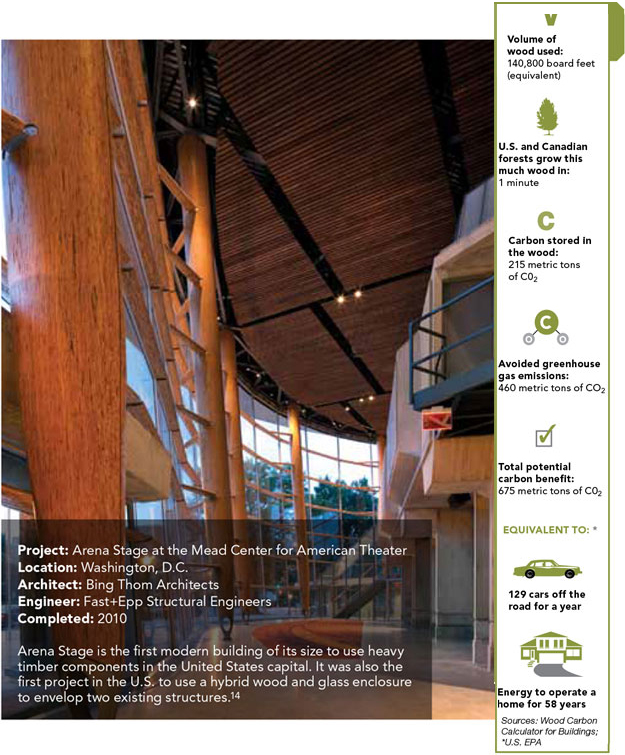
Photo by Nic Lehoux; courtesy of Bing Thom Architects
The Athena Sustainable Materials Institute undertakes similar research and also develops and maintains LCA tools for use by North American building designers. For example, the Athena Impact Estimator for Buildings is a robust, easy-to-use software tool for evaluating the environmental footprint of whole buildings and building assemblies. Free to design and building professionals (www.athenasmi.org), it can model over 1,200 structural and envelope assembly combinations, taking into account the environmental impacts of material manufacturing, including resource extraction and recycled content, related transportation, on-site construction, maintenance and replacement effects, and demolition and disposal. It provides a cradle-to-grave life cycle inventory profile, with results covering energy and raw material flows (from and to nature) plus emissions to air, water, and land.
Wood: Solid Enough for Scrutiny
As the choice of building materials receives more scrutiny, and life cycle costs are more precisely analyzed, wood's environmental benefits throughout its use and re-use in buildings are being extensively documented.
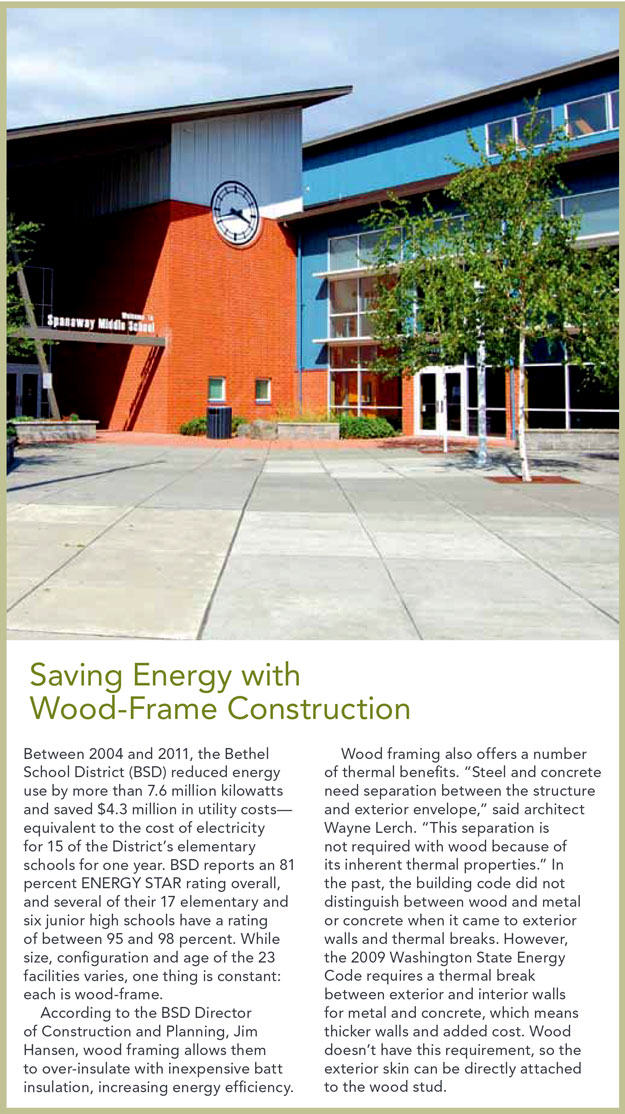
Photo: Spanaway Middle School, Erickson McGovern Architects, Bethel School District
Low-Waste Manufacturing
On average, North American wood producers use 99 percent of every tree brought to the mill for processing. The term 'waste' is in fact largely obsolete in the context of today's North American forest products industry, as logs brought to U.S. and Canadian sawmills and other wood product manufacturing centers are converted almost totally to useful products. The sector has been making strides since the 1930s and, in terms of fiber utilization, has become a zero-waste industry.15
Low-Waste Design and Construction
Wood offers numerous opportunities for design and building professionals to reduce waste through design optimization, specification of recovered wood, and use of pre-sized framing members, or of pre-manufactured and engineered components. In many cases, clean job site waste can also be separated and taken to local recovery centers.
Adaptability and Service Life
The fact that wood buildings are easily adapted or dismantled and re-used adds to their environmental benefits. Although there are examples of wood-frame buildings that remain structurally sound after hundreds of years, North American buildings often have a service life of less than 50 years, regardless of material, because of changing needs or increasing land values.16 When one considers the embodied energy in these structures and the implications of material disposal, it is easy to understand why one of the tenets of sustainable design is that buildings should last 100 years or more. Partly this is a call for more durable materials, but another important factor in building sustainability is the use of building systems that can adapt to changing needs, either through renovation or deconstruction and re-use.
This is particularly relevant in today's non-residential sector, where the average life expectancy for buildings is 24 years, and yet 40 percent of buildings in the U.S. are more than 50 years old. With more than $3 trillion likely to be spent building or substantially renovating non-residential buildings over the next decade, building designers have a significant opportunity to reduce carbon emissions through increased wood use.
Toward Net Zero Energy
While it is fairly well known that wood products sequester carbon and typically require less energy to manufacture than other building materials, their performance related to operational energy efficiency is often overlooked.
From a thermal perspective, wood-frame building enclosures are inherently more efficient than other materials—because of the insulating qualities of the wood structural elements, including studs, columns, beams, and floors, and because wood stud walls are easy to insulate. Options also exist for insulating wood-frame buildings that aren't available for other construction types. For example, while requirements for lighting systems or mechanical systems do not change based on structural material, wood's versatility related to building envelope configuration gives designers more insulation flexibility.
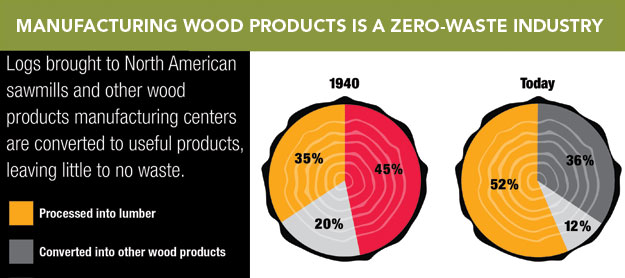
Source: Utilization of Harvested Wood by the North American Forest Products Industry, Dovetail Partners, Inc.
New wood building systems have also been developed that offer greater air tightness, less conductivity, and more thermal mass, including prefabricated systems that contribute to the low energy requirements of Passive House and net-zero designs. Passive House is an approach that uses the building's architecture to leverage natural energy sources, minimize energy consumption, and improve thermal comfort. Popular in Europe and gaining ground in North America, passive buildings rely heavily on high-performing building envelope assemblies and passive solar energy. Wood is an attractive material for passive design because of how it combines thermal mass with a number of performance merits, including water resistance, structural integrity, and finish quality. Although there are several types of net-zero-energy buildings, the term generally refers to residential or commercial buildings that are extremely energy efficient and produce the small amount of energy they do need via on-site renewable sources. Buildings may draw energy from the grid at night and return energy generated from renewable sources back to the grid during the day. The U.S. Department of Environment has a goal that all new commercial buildings be net zero energy by 2025.
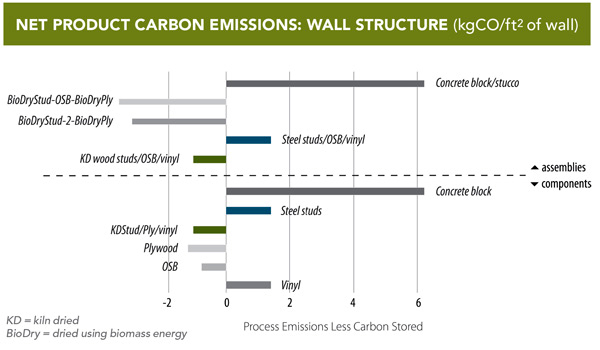
Source: Lippke & Edmonds, 2009, Building with Wood – Proactive Climate Protection, Dovetail Partners Inc.
When wood products are manufactured, low energy consumption (and very low fossil fuel consumption) results in much lower greenhouse gas emissions than when alternative materials are produced. For wood products and wall assemblies, carbon emissions (or CO2 equivalent emissions) are typically less than zero, meaning that more carbon is contained within the wood itself than is released into the atmosphere in the course of its manufacture.
Wood for a Sustainable Future
“Increasing the global forest land base and increasing the capacity of each forest, while using them as a sustainable supply of wood for building materials and fuel to offset the need for other energy-intensive materials and fossil fuels represents an important carbon mitigation option over the long term.”
—UN Food and
Agriculture Organization,
2010 report
Perhaps it is not surprising that wood, one of the oldest and most natural building materials on earth, would have a more positive environmental impact than materials that are highly energy intensive. But only recently has the analysis of products used in buildings become sophisticated enough to study and measure that impact scientifically. Actively managed forests store large amounts of carbon. Wood products are manufactured from the renewable, natural raw material that results from the forest cycle. They are adaptable and reusable, and they continue to store carbon throughout their lifetimes. These characteristics make wood an excellent, low-carbon alternative to many of the materials now widely used in construction and consumer goods. Just as wood has been a desirable building material since the distant past, it will make an essential contribution to a sustainable future.
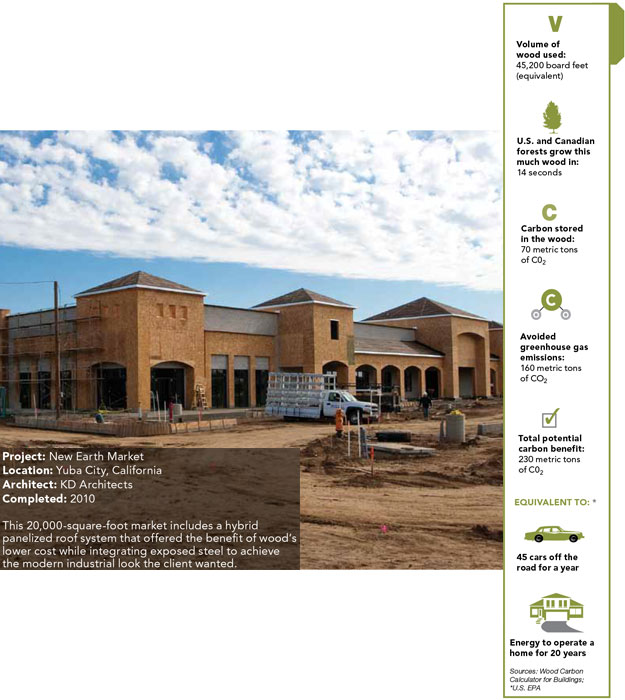
Photo by Jerry Gregg, Hilbers, Inc.
NOTE: The carbon calculations throughout this CEU were estimated using the Wood Carbon Calculator for Buildings [www.woodworks.org], based on research by Sarthre, R. and J. O'Connor, 2010, A Synthesis of Research on Wood
Endnotes
- Stella case study, 2013, http://www.woodworks.org/wp-content/uploads/Stella-CaseStudy-WEB.pdf
- U.S. Environmental Protection Agency, Greenhouse Gas Equivalencies Calculator, http://www.epa.gov/cleanenergy/energy-resources/calculator.html
- U.S. WoodWorks, Wood Carbon Calculator for Buildings, http://woodworks.org/design-tools/online-calculators/
- NC State University College of Agriculture & Life Sciences, http://www.ncsu.edu/project/treesofstrength/treefact.htm
- Bullitt Center case study, 2013, http://www.woodworks.org/wp-content/uploads/CS-Bullitt.pdf
- Building with Wood – Proactive Climate Protection, Dovetail Partners, Inc., 2015
- USDA Forest Service, http://www.fs.fed.us/research/sustain/national-report.php
- American Forest & Paper Association, http://www.afandpa.org/our-industry/fun-facts
- Impact of the global forest industry on atmospheric greenhouse gases, Food and Agriculture Organization of the United Nations, 2010, http://www.fao.org/docrep/012/i1580e/i1580e00.pdf
- A Synthesis of Research on Wood Products and Greenhouse Gas Impacts, FPInnovations, 2010
- Chadwick Dearing Oliver, Nedal T. Nassar, Bruce R. Lippke & James B. McCarter, Carbon, Fossil Fuel, and Biodiversity Mitigation With Wood and Forests, Journal of Sustainable Forestry, 33:3, 248-275, 2014
- A Synthesis of Research on Wood Products and Greenhouse Gas Impacts, FPInnovations, 2010
- Werner, F. and Richter, K., Wooden building products in comparative LCA: A literature review; International Journal of Life Cycle Assessment, 12(7):470-479, 2007
- Arena Stage case study, U.S. WoodWorks, 2011, http://www.woodworks.org/wp-content/uploads/CS-Arena-stage.pdf
- Utilization of Harvested Wood by the North American Forest Products Industry, Dovetail Partners Inc., 2012
- Survey on actual service lives for North American buildings, O'Connor, J., FPInnovations, 2004
 |
The reThink Wood initiative is a coalition of interests representing North America’s wood products industry and related stakeholders. The coalition shares a passion for wood products and the forests they come from. Innovative new technologies and building systems have enabled longer wood spans, taller walls, and higher buildings, and continue to expand the possibilities for wood use in construction. www.rethinkwood.com |
